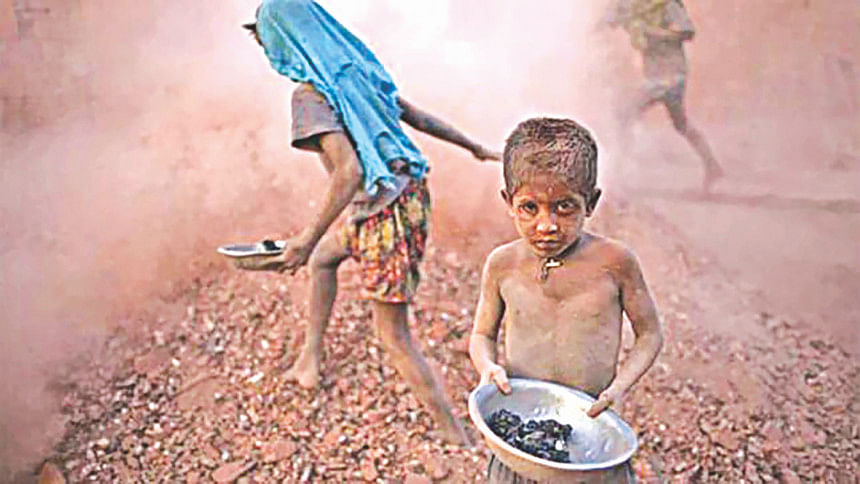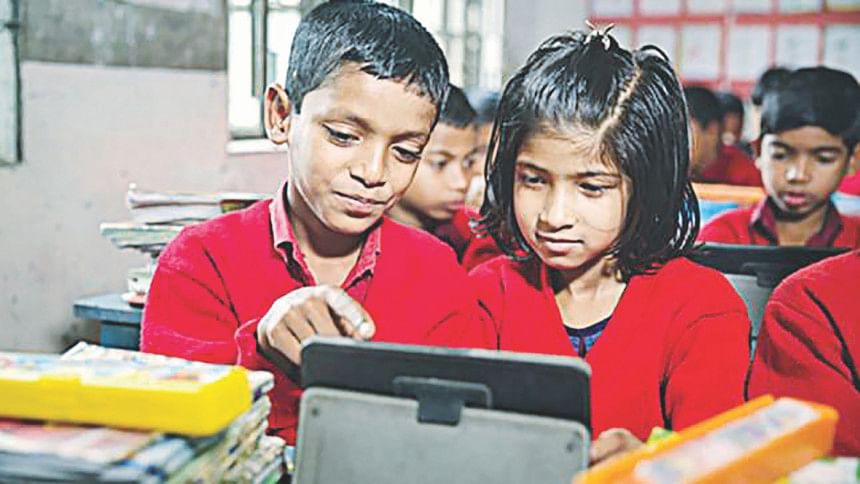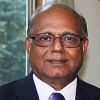Poverty and Exclusion

The poverty rate in Bangladesh in the fiscal year 2018-19 was 20.5 percent, announced Planning Minister MA Mannan on December 16, citing the latest projection of the Bangladesh Bureau of Statistics. The ratio of people in "extreme poverty" was reported to be down to 10.5 percent (bdnews24.com, December 17 2019).
The economic development narrative is justifiably upbeat for Bangladesh. There has been a high rate of economic growth over the past decade and a steady reduction of the proportion of people living below the poverty line. By regional and international developing countries comparison this is a creditable performance. However, it is subject to several caveats.
First, there is debate about how poverty rate is measured and what it means. Economist Wahiduddin Mahmud noted that Bangladesh estimates poverty based on its own measurement tools—by using what is called "the cost of basic needs" in the Household Income and Expenditure Survey (HIES). In this method, two poverty lines—lower and upper—are indicated based on two levels of consumption expenditures of households. The international practice is to use a per capita income measure—a minimum income to satisfy the basic needs of food, shelter and clothing. A dollar value of USD 1.90/day (adjusted for purchasing power parity for each country) was set as the extreme poverty threshold in 2015 by the World Bank which is commonly used for low income countries. Prof. Mahmud says if the income measure of USD 1.90 is applied, the rate of extreme poverty would be higher in Bangladesh. (The Daily Star, "Poverty line needs to be redefined: experts," February 25, 2018).
Two new international poverty lines were added subsequently by World Bank for lower middle-income (USD 3.20/day) and upper middle-income (USD 5.50/day) countries. Bangladesh has now moved up to the lower middle-income status by per capita GDP measure. About half of the population in Bangladesh would be below poverty line if the lower middle-income number of USD 3.20 is applied. Even by the official estimate based on the current modest criterion, at least 16 million people of Bangladesh are not in a position to meet their basic needs.
Secondly, while the economy has grown and poverty level has come down, the gap between the rich and the poor has widened. As per the latest Household Income and Expenditure Survey (HIES) of Bangladesh Bureau of Statistics (BBS), the country's Gini coefficient, which is the economic measure of equality, stood at 0.482 in 2016, up from 0.458 in 2010. The Gini coefficient is measured on a scale of 0 to 1; the closer it is to 1 the higher is inequality in society. A coefficient of 0.50 is regarded as a degree of inequality that is liable to generate social unrest. (The Daily Star, "Inequality at all-time high," May 19, 2019.)
Thirdly, the sources of deprivation from the benefits of the rapidly growing economy lie both in population characteristics and personal attributes of people. Where people live (e.g., remote and coastal areas, "char" and "haor", and hills with adverse ecological conditions, or being in urban slums); socio-cultural factors (such as ethnic and language status); and various personal attributes (such as, disabilities and special needs) are circumstances that are liable to marginalise people from the mainstream of society. Income poverty and gender discrimination tend to coincide with these sources of marginalisation. Targeted policy measures and affirmative actions are needed to overcome marginalisation and exclusion.
Fourthly, an aspect of the exclusion from opportunities is the large proportion of young people "not in education, employment or training" (NEET)—a situation that leaves young people without purposeful engagement, dims their hope for the future and undermines their self-esteem. Over 40 percent of the young people (15-24 years) in Bangladesh were estimated in a survey to be in the NEET category in 2013 (World Bank, "Toward Solutions for Youth Employment," 2015). This situation is not likely to have changed much. The number unemployed among youth who were looking for a job in 2018 was reported to be 4.4 million or 10 percent, more than double the general unemployment rate for the working population (World Vision Bangladesh, "Youth Employment Sub-Sectors Assessment," 2018).
Economist Rehman Sobhan defines poverty as a process that excludes significant segments of the population from opportunities to participate on equitable terms in development and decision-making. He describes this unequal opportunity for the rich and the excluded (poor) in society as "structural injustice." Drawing on cross-country experience from five South Asian countries—Bangladesh, India, Nepal, Pakistan and Sri Lanka—Sobhan identifies four sources of structural injustice. These are, along with unequal access to productive assets and unequal participation in the market, unequal access to human development (education and health) services and unjust governance.
Structural injustice does not necessarily arise from the play of market forces, but is rooted in institutional arrangements, argues Sobhan. These institutional arrangements include how the human development services of health and education are organized and the governance structure that fail to support effective services (Sobhan, Challenging the Injustice of Poverty: Agendas for Inclusive Development of South Asia.)
To sum up the points above, no country can rely on economic growth alone to end poverty in all its dimensions. For this to happen, the country's growth must benefit the poorest the most, and unlock opportunities for the extreme poor to get better jobs, access better quality health and education services, and build the foundations for the next generation to escape extreme deprivation.
In unpacking the macro-picture of inequality and exclusion, essential for finding workable solutions, we go on to examine briefly the situation of children excluded from education opportunities and whether and how use of digital technology for education and skills development can help.
Out-of-school and working children
Despite strides towards Universal Primary Education, meaningful participation in schooling with children not dropping out from primary and secondary education and acquiring the basic skills and knowledge (such as, functional literacy and numeracy) still remain a problem in most of South Asia including Bangladesh. A large proportion of the out-of-school children (OOSC) are also working children, whose participation in school is impeded by their being engaged in child labour.
A total of over 24 million in the 7-14 years age group in three countries were found out of school: India-12.3 million, Pakistan-7.3 million, and Bangladesh-4.5 million. Child labour is defined as work that prevents children from participating in schooling and is harmful to their health and growth. Statistics in this regard is imprecise, but about 17 million children are estimated to be in child labour in South Asia, including 5 million in Bangladesh. (ILO, Measuring Children's Work in South Asia: Perspectives from National Household Surveys, 2015).
Free, compulsory education up to the minimum employment age of 14 years is a crucial element in each country's efforts to tackle child labour and implement "education for all" (EFA) initiatives. Quality basic education at primary and secondary levels has the job of preparing young people, including those economically and socially marginalised, to take advantage of opportunities to develop general and job specific skills. They can then lift themselves out of poverty and find ways to become productive workers and active citizens.
A key element of the inclusion challenge is the neglect of children with disabilities. Despite some improvement in opportunities, they remain behind in enrolling in school, completing primary or secondary education, or being literate in Bangladesh and in South Asia. Disturbingly, these gaps have not been closing. Children with disabilities are being left behind by global efforts to improve education opportunities for all children (Global Partnership in Education, Disability Gaps in Educational Attainment and Literacy, Washington, DC, 2017).

Education equity and technology: Aggravating a digital divide?
Rapid technological transformation is a key feature of the economy. Technology has raised economic performance, improved efficiency, facilitated globalisation, and transformed societies. It is radically changing how goods, services, and ideas are exchanged. Can technology come to the rescue in overcoming the marginalisation and exclusion described above?
Education Technology (EdTech) including digital media for education, training and governance are proliferating through global and local collaboration. A recent Asian Development Bank (ADB) study (2017) of three South Asian countries (Bangladesh, Nepal and Sri Lanka) explored the policies and practices in ICT and their potential impact on equity, quality, efficiency and scalability in education. The study concludes that the countries need to emphasise coordinated efforts to sustain the gains and realise the potential from technology. Five strategies to optimize technology applications in education are proposed for the region: (i) Better coordination of ICT in education initiatives and quality efforts within the education sector; (ii) Better technical support for teachers as they use ICT for teaching and learning; (iii) Just-in-time and differentiated ICT in education professional support for teachers in schools; (iv) Localised and customised tutoring of teachers and students with off-line and on-line video-recorded lessons and ICT-mediated resources; and (v) Strong monitoring and evaluation of ICT use in schools. (ADB, Innovative Strategies for Accelerated Human Resource Development in South Asia: Information and Communication Technology for Education - Special Focus on Bangladesh, Nepal, and Sri Lanka, 2017.)
Governments are looking at policies and innovations from the point of view of what is called the Fourth Industrial Revolution characterised by a strong role of artificial intelligence, robotics, and "smart" means of learning as well as production of goods and services.
Can educational technology be seen as the panacea that solves major educational problems? There are clearly downsides of technology in the education context which cannot be ignored. Technology in the classroom can be a distraction unless it is handled in a blended format judiciously with guidance from the teacher. Technology can disconnect students from social interactions, especially by the lure of social media. Technology can prompt cheating in class and on assignments and make plagiarism too easy and tempting. The quality of research and sources based on "google search" still call for judgement and reasoning to reject the limitless world of "junk" and identify authentic and credible information. Proper lesson planning, updating relevant information and knowledge, and adapting these to the diverse needs of learners are labour-intensive and time-consuming tasks for the conscientious teacher, who need to be supported, as underscored in the ADB study.
Technology itself can be a source of disparity and division among learners and potential users. All students do not have equal access to technological resources, because their families cannot afford them. The majority of children in Bangladesh do not come from tech-savvy home environment. Schools themselves are not able to make the appropriate technology resources available adequately and equitably to all students, and most communities lack libraries and community resources. A new digital divide can exacerbate the existing societal divisions. How the benefits of technology outweigh the negatives, therefore, is a critical concern.
The key to education technology outcomes still is appropriate teacher-student interaction. Technology can be a highly effective tool, but that's all it can be—a tool. Technology and teachers are not substitutes of each other, though technology portends new roles and tasks for teachers. (V. Himmelsbach, 6 pros and cons of technology in classroom, 2019. https://tophat.com/blog/6-pros-cons-technology-classroom/).
Building "Digital Bangladesh" is seen by the government as the vehicle for propelling the country to the status of a modern and prosperous nation. "We want to give the students education in a modern way as part of our efforts to give them a modern technology-based education as they can move with the changing pace of the era," said Prime Minister Sheikh Hasina while launching the free textbook distribution programme for this year and receiving the primary and junior secondary public examination results on December 30, 2019 (The Daily Star, "PM stresses modern tech-based education for students." December 31, 2019).
Various initiatives are being taken to harness technology for education with better learning outcomes. A Tk 45 crore project initiated in 2018 aims to create Wi-Fi hotspots in 587 educational institutions in the eight divisions of the country. Students will have individual access to the Internet through 10 Mbps bandwidth in each institution free of charge for two years and subsequently for a small fee. The public sector Bangladesh Telecommunication Company Limited (BTCL), running the project, expects to increase the bandwidth and coverage of institutions in the future. (The Daily Star, "146 educational institutions get govt. Wi-Fi," January 13, 2020).
Equipping schools with multimedia equipment has been a major government initiative to bring technology into the classrooms. A multimedia classroom, equipped with laptops/computers, internet connection, projector and a sound system allow use of teaching-learning techniques through ICT based media. The results will depend on how efficiently and effectively these plans and programs are implemented.
Improved governance and management: Key to achieving results
The technology initiatives and the aim of transforming education and skill development by harnessing the potentials of information and communication tools can produce the results only when they are planned and designed well, managed and implemented effectively, and monitored and assessed objectively with accountability and transparency. These issues are challenges across the board in the public sector including the education sub-sectors.
A case in point is the well-intentioned initiative for multimedia classrooms in which Tk 10 billion has been already invested. "If providing 35 thousand classrooms of different educational institutions all over the country with multimedia equipment is part of the government's digitisation effort, the programme has failed to live up to the expectation," according to an editorial comment of a national daily. (The Financial Express, "Editorial," August 14, 2018).
The editorial cites the Board of Intermediate and Secondary Education noting that, "the performance of only a few districts is satisfactory in the use of multimedia technology in school classrooms. The rate of usage is negligible in most others." The obstacles include lack of qualified teachers to use and run the equipment, few teachers who can select and compile the relevant content and absent or erratic power supply. A two-week training offered to some of the teachers has not removed the shyness about technology and the reluctance to depart from known ways (Ibid).
It is obvious that achieving equity and inclusion has to be a key governance agenda in education as in other sectors. Basic information has to be collected regarding the proportion of children accessing, participating in and completing primary and secondary education, with a breakdown of students by geographic location (urban-rural, remote); socio-economic status (income quintiles); gender; ethnic-linguistic characteristics; and special needs. A useful step would be to introduce tracking of education resource flows to schools and communities. Such tracking of resources is promoted by various organisations, such as, the Global Partnership for Education (GPE), the International Institute for Education Planning (IIEP) and the UNESCO Institute for Statistics (UIS). However, the tracking of resource flow and the results is not a common practice yet and its influence on governance and management decisions is not noticeable (UNESCO, Ensuring adequate, efficient and equitable finance in schools in the Asia-Pacific region, 2017).
Manzoor Ahmed is Professor Emeritus, Brac University.

 For all latest news, follow The Daily Star's Google News channel.
For all latest news, follow The Daily Star's Google News channel. 



Comments